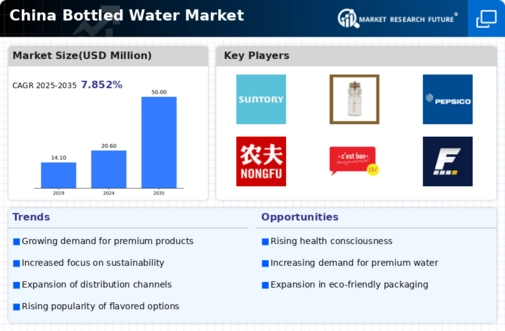Rising Disposable Incomes
The increase in disposable incomes among Chinese consumers is a key driver of growth in the bottled water market. As economic conditions improve, consumers are more willing to spend on premium bottled water products, which are perceived as a symbol of status and quality. This trend is particularly evident in urban areas, where higher income levels correlate with a greater demand for premium and flavored bottled water options. In 2025, the bottled water market is projected to benefit from this trend, with premium products expected to capture a larger share of the market. The willingness to invest in higher-quality hydration solutions reflects changing consumer attitudes towards health and wellness, further propelling the growth of the bottled water market.
Increased Health Awareness
The rising health consciousness among Chinese consumers is significantly influencing the bottled water market. As individuals become more aware of the importance of hydration for overall well-being, the demand for bottled water is expected to rise. This trend is particularly pronounced among younger demographics, who are increasingly opting for bottled water over sugary beverages. In 2025, it is estimated that the bottled water market will account for over 30% of the non-alcoholic beverage sector in China. The bottled water market is responding to this shift by introducing a variety of products, including mineral and functional waters, which cater to health-oriented consumers. This growing emphasis on health and wellness is likely to sustain the momentum of the bottled water market in the coming years.
Innovative Marketing Strategies
The bottled water market in China is witnessing a transformation driven by innovative marketing strategies employed by leading brands. Companies are increasingly leveraging digital platforms and social media to engage with consumers, promoting the benefits of hydration and the unique qualities of their products. This approach not only enhances brand visibility but also fosters a deeper connection with health-conscious consumers. In 2025, the bottled water market is likely to see a rise in targeted marketing campaigns that emphasize the lifestyle aspects of bottled water consumption. By aligning their messaging with consumer values, brands can effectively differentiate themselves in a competitive landscape, thereby driving sales and expanding their market presence.
Urbanization and Lifestyle Changes
The rapid urbanization in China is reshaping consumer lifestyles, leading to an increased demand for convenience products, including bottled water. As more individuals migrate to urban areas, the need for portable hydration solutions becomes paramount. The bottled water market is experiencing a notable surge, with urban consumers seeking easy access to clean drinking water. This trend is further supported by the growing awareness of health and wellness, as urban dwellers prioritize hydration in their daily routines. In 2025, the bottled water market in China is projected to reach approximately $20 billion, reflecting a robust growth trajectory driven by urbanization and changing consumer preferences. The bottled water market is thus positioned to capitalize on these demographic shifts, catering to the evolving needs of urban populations.
Environmental Regulations and Standards
The implementation of stringent environmental regulations in China is shaping the bottled water market landscape. As the government enforces stricter standards for water quality and packaging, companies in the bottled water market are compelled to adapt their practices. This regulatory environment encourages the adoption of sustainable packaging solutions, such as biodegradable materials, which align with consumer preferences for eco-friendly products. In 2025, the bottled water market is expected to see a shift towards more sustainable practices, potentially increasing the market share of brands that prioritize environmental responsibility. This trend not only addresses regulatory compliance but also resonates with the growing consumer demand for sustainability, thereby enhancing brand loyalty and market competitiveness.




















Leave a Comment